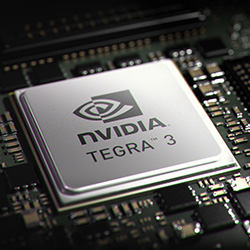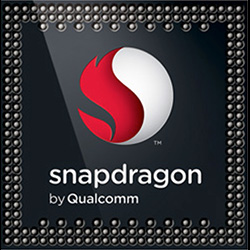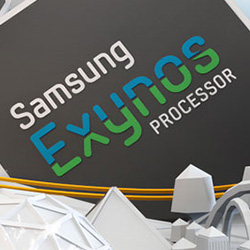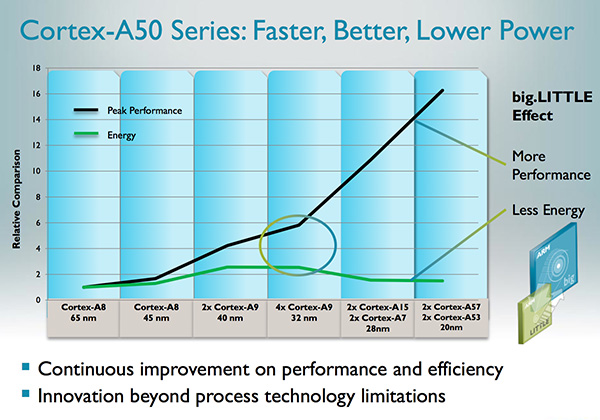ARM in a nutshell

HEXUS readers know everything there is to know about computer processors from the likes of Intel and AMD, but what about ARM?
The British company, founded in Cambridge 22 years ago and employing over 2,000 people in locations around the world, has billions of processors in the wild and in 2012 was reported to be powering a staggering 95 per cent of the world's smartphones. The statistics are mind-boggling and while there's a good chance your next desktop PC will be powered by Intel, ARM processors are almost certain to be at the heart of your next smartphone or tablet.
Each is dominant in their respective market, but the two are beginning to converge as PCs become increasingly compact and smartphones grow ever-more powerful. This huge surge in low-power computing devices has turned ARM into one of the hottest names in technology, and having built its intellectual property relatively quietly, the British outfit is now a global superstar and one that every technology enthusiast should know about.
A business model with a twist
If ARM has been designing the technology at the heart of various digital devices for the best part of two decades, why aren't ARM processors common knowledge?
There's one very good explanation; ARM doesn't actually manufacture or sell any turnkey products, so you can't go in to your local PC World and pick up an ARM processor. Instead, the company avoids the lofty costs of semiconductor manufacturing and, instead, licenses its technology to a long list of partners.
 |
 |
 |
Heard of the NVIDIA Tegra? Qualcomm's Snapdragon? How about the Samsung Exynos? These are just some of the processors at the heart of today's most sought-after gadgets, and they share a key commonality - they're all based on ARM technology.
The ubiquitous nature of ARM technology-based processors provides an insight into ARM's business model. These partner companies purchase a license to use the ARM architecture, and ARM then collects a small royalty on every chip developed using the licensed design.
The business model reminds us of Colonel Sanders; ARM has the recipe that everyone craves, and partners/franchisees are lining up to take that recipe, create a product and serve it up to the consumer in all manner of flavours.
The ARM architecture
In 2002, ARM announced that it had shipped over one billion of its microprocessor cores to date. In 2008, it announced the 10-billionth processor shipment, and today, more than 20 billion ARM technology-based chips have shipped into the marketplace.
The company's growth has been staggering, and with nearly 1,000 processor licenses sold to more than 300 companies, the ARM juggernaut is showing no signs of slowing down. But why exactly has the ARM architecture proven to be so popular, and why now?
Computer-architecture instruction sets can, for the most part, be categorised as CISC (complex instruction-set computer) or RISC (reduced instruction-set computer). CISC-based processors, such as the x86 Intel Core family, can use single complex instructions to execute several low-level operations at once. RISC processors, meanwhile, are based on the theory that simple instructions can be executed faster, enabling the processor to perform more millions of instructions per second (MIPS), resulting in high performance from a simple, power-efficient design.

The ARM architecture is not the only RISC design - MIPS and PowerPC are other examples - but it carries many of the same benefits. By using fewer, fixed-length RISC instructions, ARM technology-based processors are simpler, require a smaller number of transistors (compared to conventional desktop CPUs) and are consequently more power efficient.
Maximised efficiency leads to longer battery life, and though it's a gross simplification, this class-leading efficiency can be singled out as the driving force behind ARM's meteoric rise. Though, the evolution of consumer gadgets has certainly had a part to play. The soaring popularity of smartphones, coupled with the surge in tablet computers, has put the ARM architecture in the right place at the right time, making it an obvious choice for various devices and form factors.
Why ARM matters to you
Processors based on the ARM architecture are dominant in the smartphone marketplace, but the scale of ARM's success is arguably best realised by Microsoft's decision to produce a Windows operating system specifically for ARM.
Windows, the world's most widely-used operating system, has historically just run on the x86 architecture used by Intel and AMD. Windows 8 continues that trend, but as a sign of the growing need to support ARM platforms, Microsoft has also introduced Windows RT; a version of Windows designed exclusively for low-power ARM devices.

This change in thinking from some of the biggest names in the industry highlights the fact that the key advantages of the ARM architecture are being realised by a wider range of PC form factors.
The reduced cost of a smaller die size, coupled with lower power consumption, makes the ARM architecture a sought-after choice for new tablets and laptop computers that aim to offer ultra-thin profiles and long battery life. This trend is well under way and ARM predicts that it will capture 50 per cent of the mobile device market this year.
Putting this mobile market in context, ARM expects over 500m mid-range smartphone and tablets to be sold in 2015, up from 165m in 2012. Looking to infiltrate the burgeoning market, this is why, just recently, ARM introduced the Cortex-A12 processor, Mali-T622 graphics and Mali-V500 video chip. The trio of ARM technologies are expected to feature heavily in future mid-range products produced by a very wide range of partners.
And that, in a nutshell, is why ARM matters to you; your smartphone may already be powered by an ARM processor, but looking ahead, there's a good chance your next tablet or laptop will be ARM-powered too.







